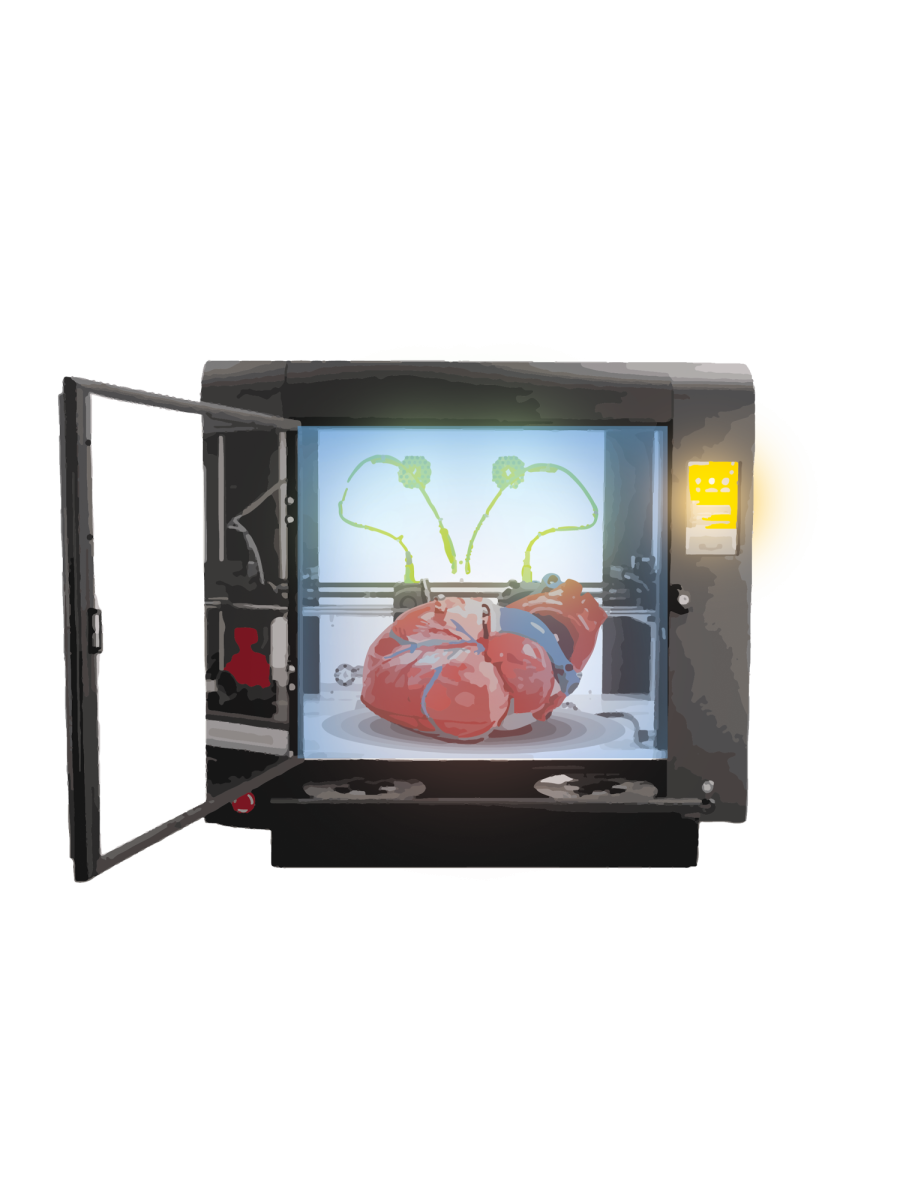Imagine a world where technology and artificial intelligence (AI) have taken over the medical field. Dying patients rely on 3-dimensional plastic hearts to save their lives. Robots perform complicated surgeries. Scientists genetically modify babies to fit the traits the parents’ desire. While these developments could improve the healthcare industry, their costs will unfortunately go unestimated.
While the use of AI has been significantly growing over the years, relying on AI would be disastrous for modern healthcare and would put an end to it entirely. The rapid use of technology in healthcare must be regulated and more heavily researched before full-scale implementation. It poses severe ethical risks that could undermine equal access, data privacy and core human values. We must proceed cautiously with robust public discourse to establish guardrails.
CRISPR
CRISPR is a technology that allows scientists to selectively modify the DNA of organisms. While it provides many advantages, it can be detrimental to the field of biology.
According to the National Institute of Health, CRISPR is being widely used to correct many genetic variants and mutations. However, most notably, it has been used to modify human embryo cells so that a baby carries certain traits desired by the parents. Although such practices can be beneficial when it stops the passing along of HIV from parent to child, taken too far, the modification of DNA can get frighteningly close to eugenics, a belief and practice that aims to improve the genetic quality of the humans.
Eugenics has a painful history, as it was adopted by Nazi Germany to justify their actions.
Consequently, more than 200 patients have already been treated with experimental CRISPR therapies resulting in many unsuccessful outcomes according to the MIT Technology Review. Currently, scientists have observed many drawbacks including inaccurate changes in DNA in regions other than the target site and its efficiency and incomplete editing.
“Regarding potentially faulty information, I think that this issue is inevitable when using technology,” junior Jerry Chen said. “For example, when teachers use technology to enhance the classroom experience by displaying a presentation, there will occasionally be technical difficulties.”
According to a study conducted by the University of Cambridge UK in 2021, a team of scientists found that some human embryos lost larger regions of chromosomes when they were edited through CRISPR.
“[CRISPR] is going to cause problems by altering genes and unmasking new problems,” said John Kupferschmid, a congenital heart surgeon at Pediatrics Specialists of Texas.
3D Printed Organs
3D-printed organs are created using bio-ink: a material consisting of cultured cells that are paired with biopolymer hydrogels to help construct structures.
“Since all the organs in the body consist of several cell and tissue types, a specific bio-ink must be developed to suit their exact requirements,” said Niina Matthews, a PhD Candidate working at the University of Technology Sydney developing 3D-printed organs. “Cells organize into different types of tissues, and when tissues are assembled together, the end result is an organ.”
There have already been examples of this technology being implemented. In 2023, doctors successfully implanted an outer ear which was 3D printed using the woman’s own cartilage cells on a 20-year-old woman.
“I think that in 10 years we will have organs for transplantation,” professor Tal Dvir, said director of tissue engineering and regenerative medicine at Tel Aviv University in Israel. “We will start with simple organs like skin and cartilage, but then we’ll move on to more complicated tissues.”
Multilayered skin, bones, muscles structures and blood vessels have already been 3D printed. However, many of these have not yet been approved as they have been deemed unsafe by medical experts.
Many are anticipating to place a printer right next to a bedside of a patient suffering from serious wounds.
However, The 3D printing process is wildly unpredictable with challenges ranging from biomaterial degradation, tissue integration and biocompatibility all of which pose significant challenges. Since there has been a lack of cases and testing in the bioprinting field, the field will encounter a plethora of difficulties for researchers to follow.
“The body is very complex,” said Biology teacher Bryan Moretz, who received a bachelor’s degree in biotechnology. “There are a lot of unknowns when we do these types of things even. Today, when we go from human-to-human transplant, there’s still uncertainty as to what’s going to happen.”
Despite these organs being developed for all socioeconomic classes, they will be only limited to the elite wealthy, defeating the whole purpose for what this invention was originally intended for.
Telemedicine
Telemedicine, the remote diagnosis and treatment of patients by means of telecommunications technology, is becoming more prominent in our day-to-day lives. It can often lead to incorrect diagnosis, misunderstandings, poor patient care and low adoption.
According to law firm Halberg and Fogg nearly 70 percent of telehealth medical malpractice claims were diagnostic issues.
“If I’m seeing a baby, I can tell more about that baby’s cardiac output and well-being by feeling that baby’s foot,” Kupferschmid said. “I can’t do that over the phone.”
With the rapid advancements of technology, both providers and patients are upset with the challenges of adapting to this new era, where everything is so technology driven. Because citizens possess varying levels of technological skill sets, companies risk the dangers of setting everyone up for failure. According to Forbes, 28 percent of providers label tele health as extremely frustrating.
Artificial Intelligence
Google Health recently released its ambitions for its involvement in health and medicine through AI and technology. During Google Health’s annual event, The Check Up, executives shared updates about new developing AI models.
According to FierceHealthcare’s press release on March 19, 2024, “The company is fine-tuning its Gemini model for the medical domain, building a personal health large language model (LLM) that can power personalized health and wellness features in the Fitbit mobile app, developing AI models to help with early disease detection and researching ways that generative AI can assist with medical reasoning and clinical conversations.”
Letting companies like Google control private medical data could prove dangerous in the future as they could release significant billions of personal information to the government.
It was revealed in April that Google’s Incognito Chrome browser explicitly states that they collect data from third-party websites regardless of the user’s browser, highlighting their dishonesty to their users.
“[Google] might tell you that it’s private, but you should always assume that anytime that you use AI, [your private data is] going to be out there,” Moretz said. “Someone’s going to be storing it on a server somewhere and it’s possible that it could leak.”
Future of Medicine
Slowly integrating these currently dangerous technologies into the medical system will undoubtedly bring numerous benefits.
“[AI] has the potential of being a game changer in a couple of areas,” Kupferschmid said. “AI can handle lots of data because it’s all computer files. There’s a million things you could put into a database, and it could really help you with diagnosing things early.”
However, scientists are implementing these technologies too quickly into the lives of humans. Without the proper testing and regulations being enforced, the future of medicine is in serious danger.
The whole point for AI was to make the jobs of humans more efficient, not replace them. There has never been a greater need for lifting the voices of healthcare workers. A 2016 report from the University of Toronto’s Mowat Centre said Canada could see automation cut 7.5 million jobs across all sectors in the next few decades.
“In the short term, there will definitely be an adjustment period where people may face job loss or other issues,” Chen said.
Moretz states the importance of humans controlling healthcare.
“[Biologists] are able to bring that connection that [AI] just can’t bring and so I don’t think anytime soon at least they will be replacing biologists,” Moretz said.
Implementing AI and these technologies will have devastating consequences for the lives of people and will unleash chaos in the medical field if we do not slow down these rapid developments.
“We should never be 100% reliant on these technologies for one big reason and that is morality,” Kupferschmid said. “If you don’t have a moral code overlying [technology], all of this will get out of hand. That’s where the human comes in, something you’ll never get from machines or technology.”









